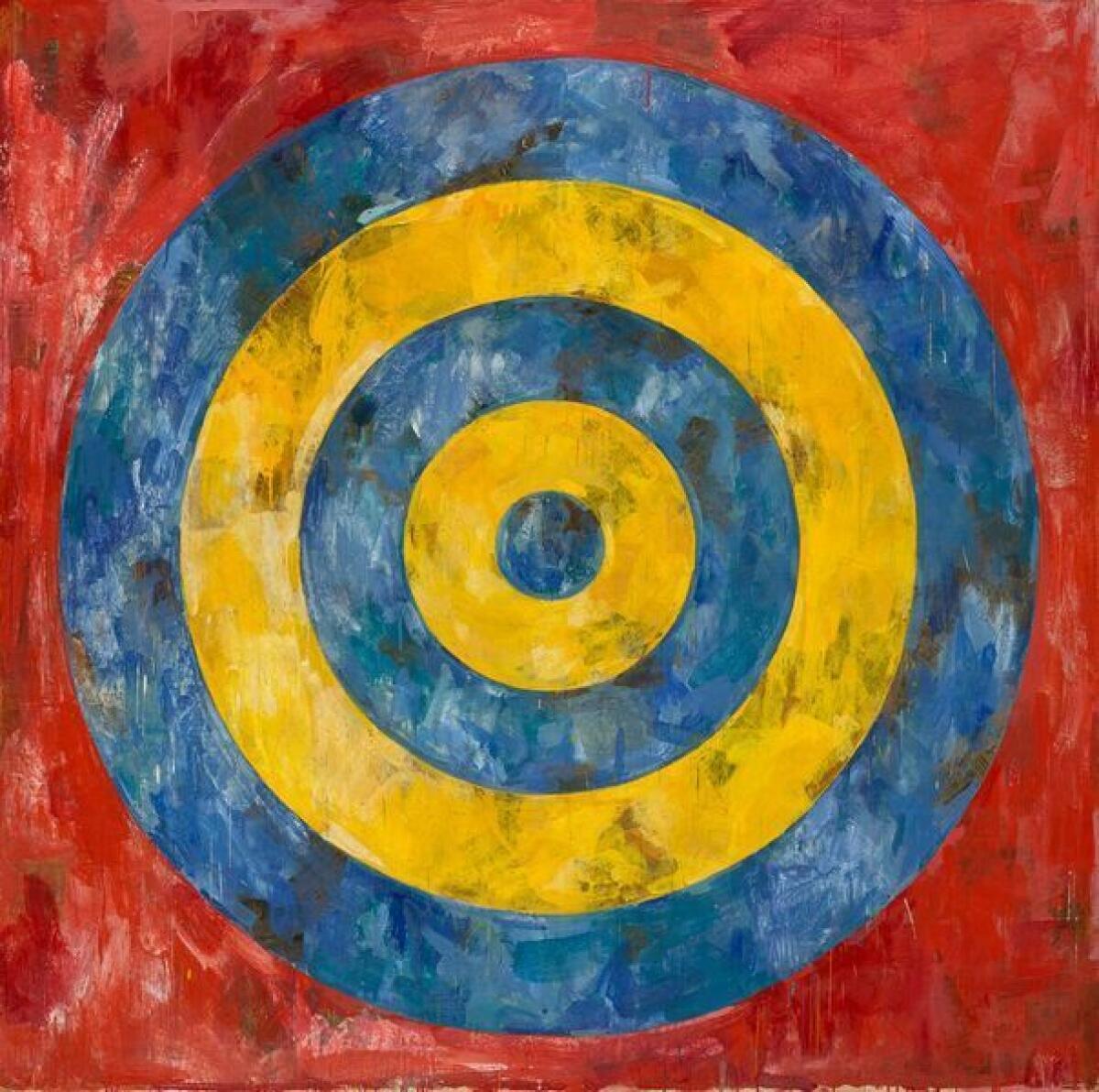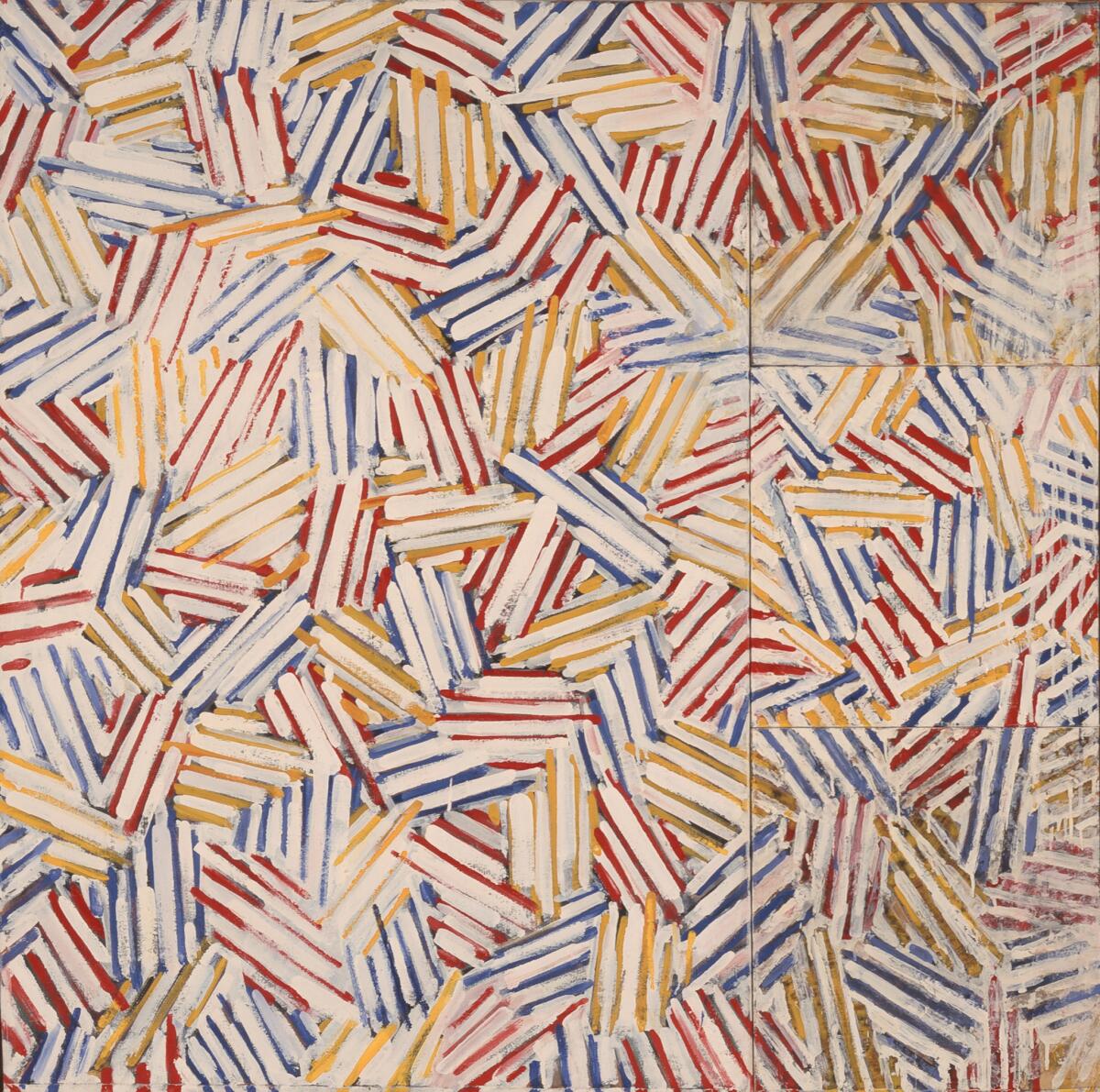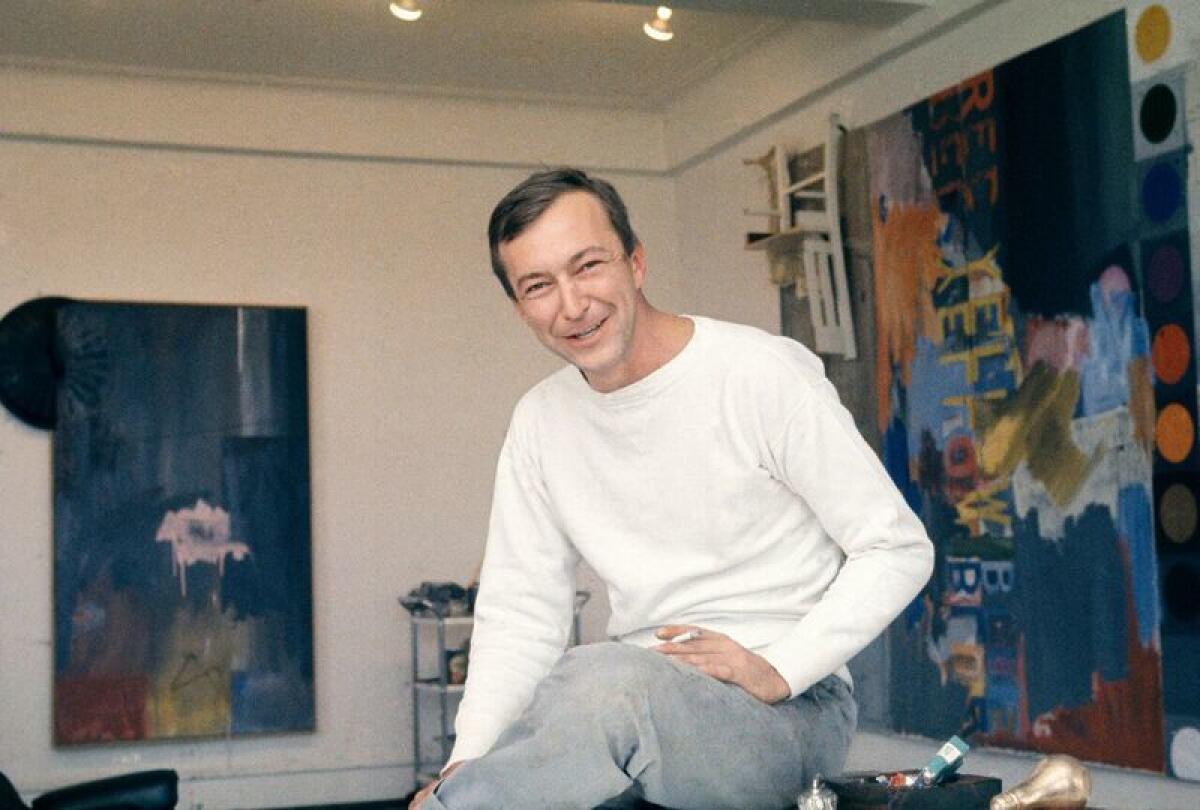‘Three Flags’ and other rare Jasper Johns works unveiled at the Broad
One night in 1954, Jasper Johns had a dream: He was painting the image of an American flag. He rose the next morning, stretched his bed sheets into a makeshift canvas and began re-creating the picture lingering in his head.
More flags followed, now among his most iconic motifs.
The morning after President Trump’s State of the Union address, one of Johns’ most significant flag paintings — stacked canvases known as “Three Flags” — went up on a gallery wall at the Broad museum. The work, on loan from the Whitney Museum of American Art in New York City, almost never travels. It has been on loan only four times since the museum acquired it in 1980. It’s one of Johns’ earliest flag paintings and, as an encaustic work painted with a mixture of melted beeswax and pigment, it’s also one of his most delicate.
At the Broad, “Three Flags” was hung in a protective Plexiglass “bonnet” for the exhibition "Jasper Johns: ‘Something Resembling Truth,’ ” the first U.S. survey of the artist's work in more than 20 years. The show, organized by the Royal Academy of Arts in London and co-curated by the academy’s Edith Devaney in collaboration with the Broad, opens Saturday and is the only U.S. stop of this tour.
The exhibition presents six decades of Johns' work, including more than 120 paintings, prints, drawings and sculptures, with an eye toward illuminating through-lines and changes in the artist's oeuvre. Many of the works haven't been displayed in Los Angeles before.
“To see all these masterworks together is just — it’s transcendent,” said Broad Director Joanne Heyler, who was overseeing the installation of “Three Flags” along with Matthew Skopek, a painting conservator from the Whitney.
Heyler and the Broad’s Ed Schad co-curated the L.A. incarnation of the exhibition, which includes eight significant works that didn’t show in London, “Three Flags” being one of them. The show is organized thematically, as it was presented in London, rather than chronologically, which is unusual for a survey exhibition. By juxtaposing Johns’ early and late-career works, as well as the various media he worked in, the exhibition illuminates recurring imagery and concepts in Johns’ oeuvre, not to mention the innovation he was known for.

Unlike at the Royal Academy, the Broad’s first gallery in the show is devoted entirely to the artist’s flags. It's an intimate space chock-full of red, white and blue — and orange and charcoal gray. There’s his small 1955 graphite drawing, “Flag,” the earliest flag work in the show; and there’s the so-called 1958 “Leo Castelli flag,” a five-foot-wide flag with thick, prominent brushwork rendered entirely in wax and paint, that was in the late New York gallerist’s family for decades. The painting of two flags against a gray background, “Flags” (1965), is from Johns’ personal collection.
“Three Flags,” created in 1958 when Alaska and Hawaii weren’t yet states, has just 48 stars on it. It hangs beside the Broad’s “Flag” (1967), which has 50 stars on it.
Like all of Johns’ works featuring common signs and symbols — flags, targets, numbers, letters, maps — the flag works not only challenged the premises of abstract expressionism, but also questioned the medium of painting itself. His flags weren’t meant to be emotional or political statements as much as purely visual ones, the familiar image suddenly unfamiliar in its new context. The depiction on canvas is, simply, a painterly gesture, both the picture of a flag and an object unto itself.
But it would be hard to imagine a roomful of flags not resonating today.
“Although his mind wasn’t on politics when he launched this series,” Heyler said, “it’s interesting, as a historian, to look at context in the ’50s and McCarthyism and what was going on in the country then. Given that we’re currently living through a rather turbulent moment, politically, now, I’m sure visitors will reflect on that as they look at these images.
“But they also are so compelling as paintings. They’re just crafted and painted so masterfully, and that’s an equally critical piece to understanding what’s going on in this gallery.”
The flag paintings — like all of Johns’ works depicting symbols — Schad added, disrupt viewers’ knee-jerk reactions and instead “slow that way down, to the point of an object and an image and what a thing does in the world.”

Eight thematic sections lead the viewer through the exhibition. “Things the Mind Already Knows,” which the flags are part of, presents some of Johns’ best known images, playing with the viewers’ sense of perception regarding everyday objects. “Words and Voices” shows how Johns saw language in relationship to visual perception; it includes a series of Samuel Beckett narrative shorts, for which Johns created prints evoking the language. “Time and Transience” includes the first Johns painting, “Untitled (1975),” which museum founders Eli and Edythe Broad acquired in 1978, an abstract-looking piece with jagged colorful markings.

“In the Studio” focuses on the life of an artist and includes Johns’ famous sculpture, “Painted Bronze” (1960), of a coffee can filled with paint brushes. “Fragments and Faces” includes Johns’ “Perilous Night” (1982), in which he silk-screened a page from a John Cage score onto the canvas. “Seasons and Cycles” pulls together Johns’ Seasons paintings — the first time all four have been shown together in L.A.

Johns, who is 87 and lives in Connecticut, isn’t traveling to L.A. for the exhibition or doing interviews, the Broad said, but the show has already generated much excitement given its sheer breadth. In addition to private loans as well as pieces from the Broad’s collection and from the artist himself, nearly every major museum in the U.S., and several internationally — including the Museum of Modern Art in New York, the Art Institute of Chicago, the National Gallery in Washington, D.C., and the Tate, London — contributed key artworks. For the Broad Art Foundation, which has made more than 8,500 loans since the early ’80s, Heyler said, this collective effort to create “ ‘Something Resembling Truth’ ” feels like “the completion of a collegial relationship.”
That collaborative spirit crosses over into programming around the exhibition. Johns is a reader and lover of the arts, an interdisciplinary thinker who collaborated with close friends such as choreographer Merce Cunningham and composer Cage. The programming lineup blends dance, poetry, live discussions and music.
The “Cross-Hatched” series will feature pianist Adam Tendler performing with experimental vocalist Joan La Barbara; Tendler will also provide piano accompaniment to snippets from dance films from the Merce Cunningham Trust. For an evening called “Incidents and Echoes,” Tendler will perform Cage compositions that share titles or other connections with Johns’ paintings.
The Broad will also present the “Unfolding Language Literary Series” in collaboration with the Library Foundation of Los Angeles’ Aloud program. Over two evenings, L.A. authors such as Chris Kraus and Rigoberto Gonzalez will read their own work and the work of authors who inspired Johns, like Beckett, Herman Melville and Hart Crane.

Johns’ influence has shaped Pop and Conceptual artists in the Broad’s collection, such as Robert Rauschenberg, Ed Ruscha, Andy Warhol, John Baldessari, Sherrie Levine and Bruce Nauman.
“It’d be hard to find too many artists working with paint and making paintings that don’t owe some kind of debt to Jasper Johns,” Heyler said.
But Heyler is especially interested in how the exhibition, and its programming, will affect artists previously unfamiliar with Johns’ work.
“Los Angeles is such a center for art practice. It has some of the nation’s best art schools. I’m really looking forward to seeing how it influences how young artists are thinking today in L.A.,” she said.
“Because this is the kind of show that will reward close, intimate viewing. This work pulls you in.”
♦ ♦ ♦ ♦ ♦ ♦ ♦ ♦ ♦ ♦
‘Jasper Johns: “Something Resembling Truth” ’
Where: The Broad, 221 S. Grand Ave., L.A.
When: Opens Saturday, ends May 13
Tickets: $25; free for ages 17 and younger; reservations recommended
Information: www.thebroad.org
Follow me on Twitter: @debvankin
UPDATES:
FOR THE RECORD
8:31 a.m.: An earlier version of this article stated that Matthew Skopek is a curator. He is a painting conservator. The article also referred to the Broad Foundation but should have said Broad Art Foundation.
The biggest entertainment stories
Get our big stories about Hollywood, film, television, music, arts, culture and more right in your inbox as soon as they publish.
You may occasionally receive promotional content from the Los Angeles Times.








